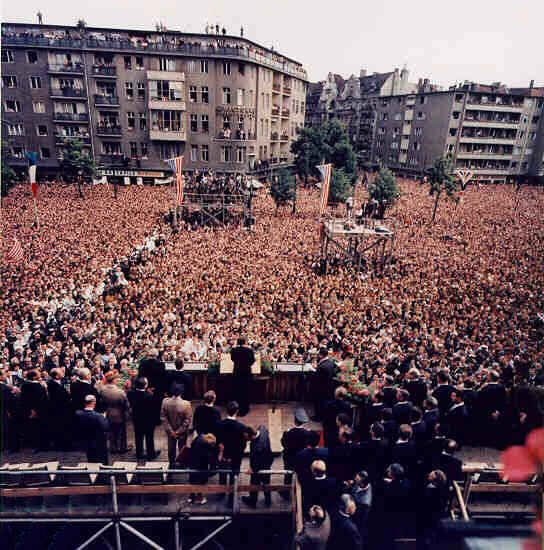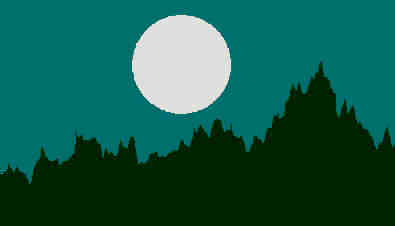|
Condamnés à mort par la Révolution:
^top^
1794 (08 messidor an II):
GUNTHER Michel, domicilié à Sehweincheim (Bas-Rhin),
par le tribunal criminel dudit département, comme receleur de Grains.
GUILLABERT Joseph Martin Basile, ex vicaire, domicilié
à Colobrières (Var), par le tribunal criminel du département de
l'Isère, comme réfractaire à la loi.
BEVENAS François Marie, ex vicaire, domicilié à
Damezieux (Ain), comme infracteur à la loi, par le tribunal criminel
du département de l’Isère.
MONIN Jean Pierre, 26 ans, natif de Séciné (Isère),
déserteur du 2ème bataillon du 33ème régiment, domicilié à Lyon
(Rhône), comme déserteur , par la commission militaire d'Avesnes.
BERNARD Toussaints, perruquier, domicilié
à Nancy (Meurthe), comme émigré, par le tribunal criminel dudit
département.
FOULON Anne Angélique, femme Garbet, domiciliée
à Paris, par le tribunal criminel du département de la Meurthe,
comme émigrée.
HUSSON Claude, domestique domicilié à Preny (Meurthe)
, par le tribunal criminel dudit département, comme émigré.
DUBROEUCQ Reine Françoise, âgée de 38 ans, née
à Camblain Chatelain, demeurant à Loos, veuve de Vuvelois N., guillotinée
à Arras
PRUVOST Jean Simon, 43 ans, né à Loos, cultivateur,
époux de Delambre Marie Madeleine, à Arras
VESTAVELLE Jean Baptiste, 31 ans, né à Hazebroucq,
marchand à St Omer, époux de De Voor Louise, à Arras
Domiciliés dans le département
du Vaucluse, par la commission populaire séante à
Orange:
PRATICOUX Joseph, ouvrier taffetatier, domicilié
à Avignon, comme contre-révolutionnaire.
GROS Charles, messager et salpêtrier, domicilié
à Roubion, comme fédéraliste.
...
domiciliés à Avigron, comme fédéralistes:
MARIA Antoine Joseph, ouvrier taffetier —
MONTAUD Félix, salpêtrier — VACHET
Claude, marchand charcutier — VINCENT René,
sellier
Domiciliés
dans le département de la Gironde, par
la commission militaire séante à Bordeaux:
BILLOI Jacques, gantier, 55 ans, né dans la commune
de Rudy (Basses-Pyrénées), domicilié à Bordeaux, comme receleur
de prêtres réfractaire.
DORNAL Mathurin (dit Degui), prêtre insermenté,
natif de St Ferme, domicilié à Bordeaux, comme réfractaire à la
loi.
DURAND Marguerite, ex religieuse, âgée de 26 ans,
née à Marmande (Lot et Garonne), domicilié à Bordeaux,
MAUVIGNÉ Pierre Colas, ancien militaire
et cultivateur, domicilié à St Christophe-de-Doubs, comme contre-révolutionnaire.
Par le tribunal révolutionnaire
de Paris:
LOPS Léon, faiseur de balances, 50 ans, né à Amsterdam,
domicilié à Paris, comme convaincu d'avoir acheté du numéraire,
avili les assignats, la Convention et le gouvernement révolutionnaire.
MAILLETCONTE Jean Baptiste, domestique, 16 ans,
né à Mezene (Mont-Blanc), domicilié à Paris, comme convaincu d'avoir
acheté du numéraire, d'avoir avili les assignats, la Convention
nationale, le gouvernement révolutionnaire.
MERET Nicolas, 54 ans, commissionnaire, né à Macot,
domicilié à Paris, comme convaincu d'avoir acheté du numéraire,
avili les assignats, la Convention et le gouvernement révolutionnaire.
VALTON Antoine, 29 ans, natif de Collet, département
du Rhône, domicilié à Paris,comme ennemi du peuple, ayant acheté
du numéraire, le faisant passer aux ennemis de la République, et
discréditant les assignats.
WENANTSPIES Laurent, 56 ans, né à Rotterdam en
Hollande, domicilié à Paris, comme ennemi du peuple en faisant des
achats en numéraire, pour le faire passer aux ennemis de la république.
ROSSIER Bernard, marchand mercier, tenant échoppe,
47 ans, né au Fort-Baneau (Isère), domicilié à Paris, comme convaincu
d’avoir été un des généraux perfides.
BAIL SIMON, employé aux charrois, domicilié à Jussy,
canton de Metz (Moselle), comme contre-révolutionnaire
BILLON Louis Charles Maurice, clerc de procureur,
domicilié à Paris, comme contre-révolutionnaire
DESAULNETS Maxime, huissier prieur, et administrateur
du département de Paris, domicilié à Paris, comme contre-révolutionnaire.
...
comme convaincus d'être complices du complot des prisonniers dans
la maison d'arrêt de Bicêtre, d'égorger la garde cette maison,
d'en forcer les portes, de se porter à la convention, et singulièrement
aux comités de sûreté générale et de salut public; d'en égorger
les membres, de leur arracher le cœur, de la faire rôtir, de le
manger, et de livrer Paris au pillage, pour servir la faction de
l'étranger:
AMAND Louis, 35 ans, maçon, né et domicilié à Vincennes
(Seine).
BARON Maurice- Laurent, sergent au batil. De la
réunion, domicilié à Franciade (Seine).
DARCON Jean (dit Darcu), 35 ans, né à Drude, scieur
de long, domicilié à Fontainebleau (Seine et Marne).
DARTHUS Adrien, tailleur, 25 ans, né et domicilié
à Rouen (Seine Inférieure).
CARBONNIER Louis, (dit Bauf), manœuvrier, 36 ans,
né à St Aubin (Oise).( exécuté place de Vincennes, inhumé à Picpus)
JACQUINET François (dit Montauciel), soldat dans
la légion Belge, 33 ans, né et domicilié à Bourbonne-les-Bains (Haute
Marne).
LAPOINTE L. Cl. Raimond, 26 ans, né à Nantes (Loire
Inférieure), homme de loi, domicilié à Romainville (Seine).
LARCHE Joseph, maçon, 36 ans, né à Fontainebleau
(Seine et Marne).
LEMASSON Joseph Marie, 65 ans, né à Rennes (Ille-et-Vilaine),
domicilié à St Servan, même département, chirurgien, qui avait été
condamné à la déportation, le 18 juin 1793, par le tribunal révolutionnaire
de Paris, comme complice de la conspiration, connue sous le nom
de "Bretagne", dont le ci-devant marquis de la Rouerie était le
chef ou l'un des principaux agents sous l'autorisation et l'appui
des frères du ci-devant, roi.
LENDROIT Louis Frédéric, batteur de plâtre, 23
ans né et domicilié à Montdricourt (Aisne).
MARQUIERT Louis Vincent, prêtre et hussard, 32
ans, né et domicilié à Carcassonne (Landes).
MIGNARD Antoine, brocanteur, 26 ans, né et domicilié
à St Flour département du Cantal, par le tribunal révolutionnaire
de Paris, comme complice d'un complot dans la maison d'arrêt de
Bicêtre, tendant à égorger la garde de cette maison, se porter aux
comités de salut public, de sûreté générale, en égorger les membres,
leur arracher le cœur, le faire rôtir et le manger.
MOURET Antoine, soldat du 78ème régiment, 29 ans,
né et domicilié à Strasbourg département du Bas-Rhin, par le tribunal
révolutionnaire de Paris, comme complice d'un complot dans la maison
d'arrêt de Bicêtre, tendant à égorger la garde de cette maison,
se porter aux comités de sûreté générale, en égorger les membres,
leur arracher le cœur, le faire rôtir et le manger.
PICHON Nicolas, limonadier, 34 ans, natif de Chalon-sur-Saône
(Saône et Loire), domicilié à Lyon (Rhône).
SIMON S., employé aux charrois, 34 ans, natif de
Sasie (Moselle).
TROUVE Louis Michel, 58 ans, ex curé de Moissy,
né à Allouville (Seine Inférieure), domicilié à Moissy (Seine et
Marne).
VIEILLEPEAU François, marchand de sel, 23 ans,
natif de Mabrie (Orne)
BILLION Louis Claude Marie, clerc de procureur,
26 ans, né à Paris.
... domiciliés à Paris:
ADET Charles, marchand de vin, 31 ans, né à Andelet
(Haute Marne). — ALLAIN Jean Baptiste, 26
ans, né à Pleinseuvre, fabricant de Plombs.
ASSELINOT Jean Gabriel, 31 ans, né à Cosne, épicier.
— BEAUFORT
Marc François, 32 ans, tabletier
BLOT Joseph, fils, négociant. — DANGERS
Claude François, 47 ans, né à Chasey, ex administrateur
de police.
DURUT Claude Louis, teneur de livres. — FRANCOT
Pierre, brocanteur, 61 ans, né à Beville (Seine et Oise).
GUY Michel Clément, 36 ans, né à Macot (Mont-Blanc),
commis marchand de vin à Paris. — HOT Hugues,
jockey, 17 ans, né aux Avanchais (Mont-Blanc).
HUSSE François, 40 ans, né à Cé, .condamné d'abord
à 16 années de fers, en conséquence détenu à Bicêtre, puis
à mort .
MESTRIOT Jacques François, gendarme de la 29ème
division, né à Dezouy en Zosias, . par le tribunal révolutionnaire
de Paris, comme complice d'un complot dans la maison de Bicêtre,
tendant à égorger la garde de cette maison, se porter aux comités
de salut public, de sûreté générale, en égorger les membres, leur
arracher le cœur le faire rôtir et le manger.
PICARD Louis Paul, pâtissier, 35 ans, natif de
Ste Magnance (Yonne)
...
et nés à Paris:
OSSELIN
Charles Nicolas, 40 ans, homme de loi, ex président
du tribunal du 17 août 1792, député de Paris à la convention nationale,
condamné à la déportation, le 15 frimaire an 2, par le tribunal
révolutionnaire de Paris, comme convaincu d'avoir, en abusant de
son caractère et de sa qualité de membre du comité de sûreté général
de la convention, pour prêter secours à Charlotte Félicité Luppé,
femme du ci-devant marquis de Charry, émigré, il a été déposé dans
la maison de Bicêtre en attendant qu'il partit. Lorsqu'il était
apprit qu'il était compris dans cette conspiration, et qu'il devait
paraître au tribunal, il arracha un clou de sa chambre qu'il s'enfonça
dans le côté; il fut conduit à l'audience sur un brancard, et presque
mourant; il ne fut pas possible alors d'entendre ses paroles tant
sa voix était affaiblie, ce qui obligea le président à se transporter
près de lui pour prendre ses réponses.
BEAUDOT Louis, 21 ans, chirurgien, comme contre-révolutionnaire
— BOSQUET Louis Jérôme Auguste, gagnedenier,
26 ans
COTTEL Claude, 20 ans, soldat au 19ème régiment
— DESCHARMES-SILLERY Charles Alexis, 19 ans,
ex aide de camp, comme contre-révolutionnaire ...
SENLISSE Henri, ex vicaire de Dt Louis en l'Isle,
34 ans, qui avait été condamné à la déportation, le
22 frimaire an 2, par le tribunal révolutionnaire de Paris, comme
convaincu d'avoir tenu des propos inciviques.
1793:
PAGES Antoine, déserteur, domicilié à Bruel-d’Esclanèdes
(Lozère), comme contre-révolutionnaire, par le tribunal criminel
dudit département. |
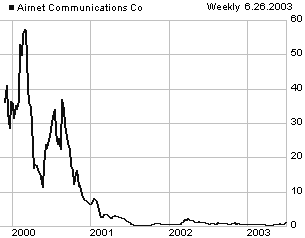 On
a 26 June:
On
a 26 June: 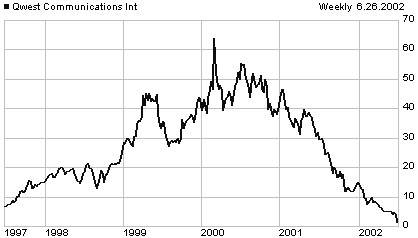 2002
AG Edwards upgrades (yes: up!) from Sell to Hold the shares
of Qwest Communications International (Q), which fall from their previous
close of $4.19 to an intraday low of $1.20 and close at $1.79. They had
traded as high as $64.00 on 28 February 2000 (it would be interesting to
know what the people who bought it at that price thought then, what they
think now, and what they think now about what they thought then. More likely
than not they were short-sellers who got squeezed. Short-selling is a great
way to lose money even when you are fundamentally right.). [< 5~year
price chart]
2002
AG Edwards upgrades (yes: up!) from Sell to Hold the shares
of Qwest Communications International (Q), which fall from their previous
close of $4.19 to an intraday low of $1.20 and close at $1.79. They had
traded as high as $64.00 on 28 February 2000 (it would be interesting to
know what the people who bought it at that price thought then, what they
think now, and what they think now about what they thought then. More likely
than not they were short-sellers who got squeezed. Short-selling is a great
way to lose money even when you are fundamentally right.). [< 5~year
price chart]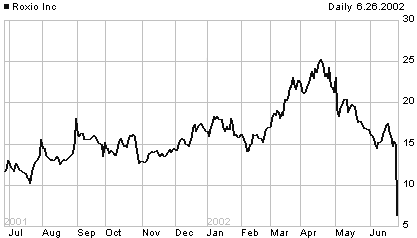 falls
from its previous close of $14.95 to an intraday low of $6.12 and closes
at $6.28. After its start at $15.89 on 30 April 2001, the stock had traded
as high $25.30 on 18 April 2002. [1~year price chart >]
falls
from its previous close of $14.95 to an intraday low of $6.12 and closes
at $6.28. After its start at $15.89 on 30 April 2001, the stock had traded
as high $25.30 on 18 April 2002. [1~year price chart >]